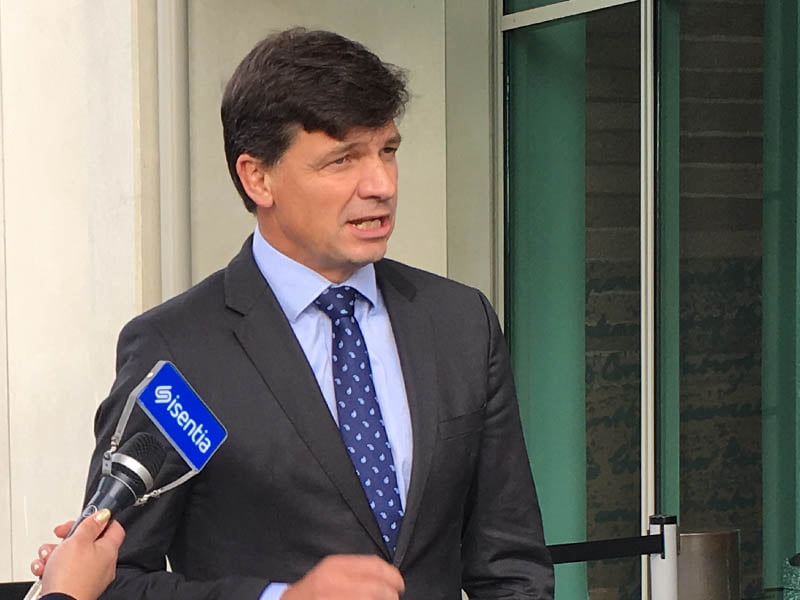The Government’s GovPass digital identity system will be firmly opt-in – citizens who don’t wish to use the streamlined platform and its biometric component won’t have to.
According to Angus Taylor Assistant Minister for Cities and Digital Transformation, “GovPass is a fundamentally important project.”
“We know that a smooth easy log on and the experience associated with that, the ability to streamline your identities with government and potentially beyond just the federal government, is one of our top priorities,” he said.

Speaking at the dinner following the Navigating Digital Government Summit in Canberra, Mr Taylor said that “this is an important and absolutely crucial whole of government project.
“I know if we get digital identity right it will offer secure, privacy-enhancing customer service that will deliver countless benefits to people and businesses.
“The crucial point is it needs to be user driven, consent based. If I want to keep 50 different identities on the internet – why you’d want to do that I don’t know, but people do – people should be able to do that.”
While the opt-in approach may address citizen concerns about the identity system, particularly its biometric component which has been likened to the Australia Card, it does risk Government failing to secure the full transformative benefits that might accrue from population-wide digital identity verification.
A similar opt-in approach to digitised personal health records led to only a small fraction of the public choosing that path.
The Assistant Minister nevertheless nominated GovPass and SmartGate as exemplars of successful Federal Government digital transformation.
The Summit held in Canberra yesterday was organised by the Australian Information Industry Association (AIIA) and focussed on how technology is transforming the customer experience in the public sector.
Not very well was the verdict of Ed Husic, shadow minister for the digital economy, employment services, workforce participation and the future of work, who spoke at the event.
While Mr Husic said that digital transformation itself was not a contentious issue and should attract bipartisan support, he warned that; “We will be as bipartisan as we can but we won’t be dragooned as cheerleaders when things go off the rails and they have been.”
After 12 months during which Federal Government has endured the Census debacle, regular ATO outages, and the shortcomings of Centrelink’s overpayment algorithm Mr Husic said these had delivered “hammerblows” to the public’s confidence about Government being able to deliver genuine service reform.
He also accused the Digital Transformation Agency of being “missing in action” with regard to proper oversight of key digital transformation initiatives.
Nerida O’Loughlin, interim CEO of the Digital Transformation Agency, also spoke at the Summit and acknowledged that “the Government’s impatience at the pace of change and inconsistent outcomes on major projects.”
“All of you know that sub-optimal outcomes on ICT and digital projects have the potential to dent public confidence not just in Government but in your industry as well.”
However she said that there had been significant progress in key areas.
She nominated the digital service standard, the emergence of reusable service platforms, and GovPass as initiatives with the capacity to shift the dial on Government service delivery.
And citizens want the dial shifted.
A Galaxy Research poll commissioned by the AIIA has already identified the gap between consumer expectation and Commonwealth reality.
Only 16 per cent of Australians polled said that Commonwealth Government was making good use of technology to deliver services. The figures were even lower for State (14 per cent) and Local (12 per cent) Governments.
All levels of Government ranked behind banks, online retail, travel, telcos, entertainment, utilities and health services.
Ms O’Loughlin, who will be replaced by incoming DTA CEO Gavin Slater from May, said; “We know users want to be able to customise their online experience to meet their lifestyle or personal needs.’
“People want to be consulted earlier so that when we design our services we do so with them in mind from the very start of the project.”
Users also want more transparency regarding progress of their applications or requests, she said.
But she admitted; “It is fair to say that user research has not driven a lot of government service works over the years but it is now front and centre of the way Government thinks about its service design.”
Ms O’Loughlin said that to address the gap between what users wanted and what was currently on offer the Government was spending more on technology than ever before.
She however noted that; “We need to do a lot more than just spend money,”
Ms O’Loughlin reinforced the need for continued change to procurement trends in Government noting that in the past 49 per cent tech contracts were awarded through panels and only 27 per cent of contracts followed open approaches to market. She said that in general SMEs still found it hard to access opportunities to help transform government services
“Many of us have been here before. Many of us remember the Gershon review and other reviews which have found similar things.
“What we want to do with the task force and with the strong support of the current Government is to try and break through on these issues because they have been holding many of you back and government services back for many years.”
She pointed to the digital marketplace now being tested and trialled by the DTA. Since August $12.5 million worth of transactions have funnelled through that site, with SMEs accounting for 78 per cent of the deals according to Ms O’Loughlin.
Compared to the multi billion IT budget of the Commonwealth however this remains a slim slice of the overall Government pie.
Disclosure: The author acted as MC of the Summit for the AIIA.
Do you know more? Contact James Riley via Email.

